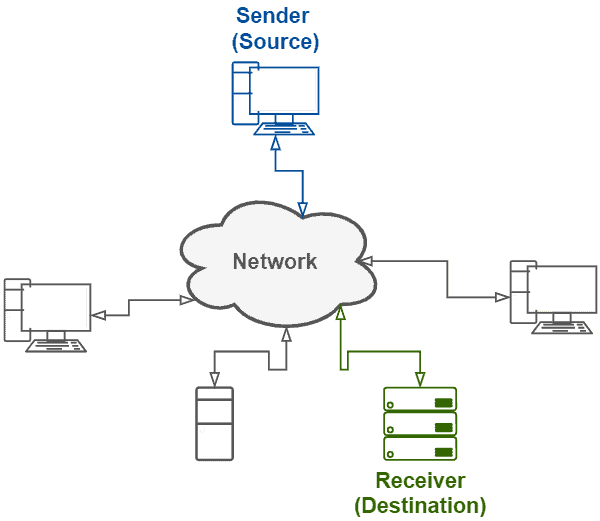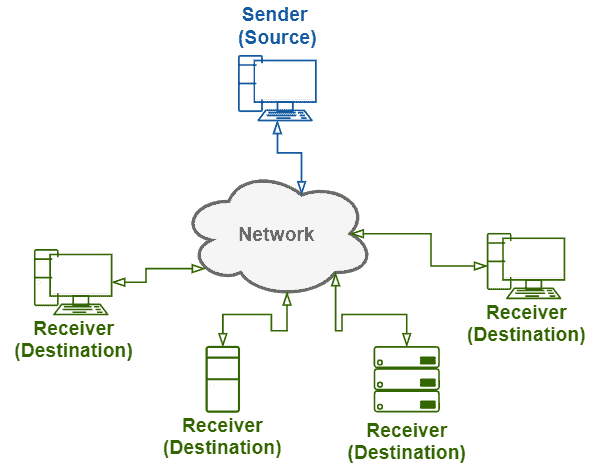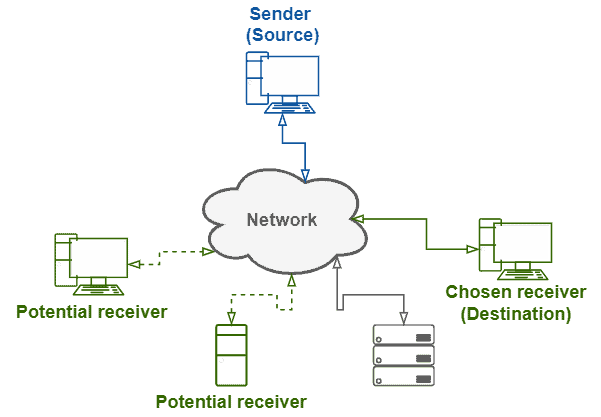1. 引言
网络通信的核心在于多个设备之间能够高效、安全地交换信息。这种通信依赖于多种技术资源,包括物理设备(如网线)、中间设备(如路由器)、协议栈以及地址分配方法等。其中,消息地址的分配方式直接影响通信效率与网络负载。 正确使用地址方法可以提升通信性能,反之则可能导致网络拥堵甚至安全漏洞。
本文将深入探讨四种主流的地址分配方法:单播(Unicast)、广播(Broadcast)、组播(Multicast)和任播(Anycast)。我们将分析它们的工作机制、使用场景、路由策略,并结合实际案例说明其优缺点。最后还会简要提及与这些地址方法相关的安全风险。
2. 地址分配方法概述
地址分配方法决定了消息的发送者(源)与接收者(目标)之间的关系。根据接收者的数量和通信方式,可以将地址方法分为以下四类:
| 方法 | 源 → 目标 | 潜在接收者数量 | 实际接收者数量 |
|---|---|---|---|
| 单播 | 1 对 1 | 1 | 1 |
| 广播 | 1 对所有 | 多个 | 多个 |
| 组播 | 1 对多个(特定组) | 多个 | 多个 |
| 任播 | 1 对任意一个 | 多个 | 1 |
接下来我们分别详细讲解每种方法。
2.1 单播(Unicast)
单播通信是指一个发送者向一个接收者发送数据。 这是最常见的通信方式,适用于点对点的数据传输。例如,当你在浏览器中访问一个网页时,浏览器会通过单播方式向服务器请求数据。
特点:
- ✅ 点对点通信
- ✅ 每次通信仅涉及一个接收者
- ✅ 通信路径明确,路由简单
地址范围(IPv4):
- A类:1.0.0.1 ~ 126.255.255.254
- B类:128.1.0.1 ~ 191.255.255.254
- C类:192.0.1.1 ~ 223.255.254.254
IPv6 单播地址示例:
- 全局单播地址:200::/3
- 链路本地地址:fe80::/10
- 回环地址:::1/128
路由方式:
单播路由非常简单,路由器根据目标地址查找路由表,逐跳转发即可。
应用场景:
- HTTP、FTP、SMTP、Telnet 等常见协议
- 浏览网页、下载文件、邮件传输等日常网络操作
示例图:

2.2 广播(Broadcast)
广播通信是指一个发送者将消息发送给同一网络中的所有设备。 所有设备都会接收到该消息,无论它们是否关心该消息内容。
特点:
- ✅ 一个发送者,多个接收者
- ❌ 所有设备都会收到消息(即使不需要)
- ❌ 容易造成网络拥堵
- ❌ 安全性较低
地址示例(IPv4):
- 子网广播地址:如 192.168.122.255
- ARP广播地址:FF:FF:FF:FF:FF:FF
注意:
IPv6 不支持广播地址。
路由方式:
广播消息通常不会被路由,仅限于本地网络。如果需要跨网络广播,路由器会通过多个单播消息转发。
应用场景:
- ARP(地址解析协议)
- DHCP(动态主机配置协议)
- Microsoft 浏览器协议、NTP(网络时间协议)
示例图:

2.3 组播(Multicast)
组播通信是指一个发送者将消息发送给特定组的多个接收者。 与广播不同,只有加入该组的设备才会收到消息。
特点:
- ✅ 一个发送者,多个接收者(特定组)
- ✅ 避免广播风暴
- ✅ 节省带宽
- ✅ 支持动态加入/退出
地址示例(IPv4):
- D类地址:224.0.0.0 ~ 239.255.255.255
- 前4位为
1110的地址表示组播地址
IPv6 组播地址:
- 前缀为
ff00::/8
路由方式:
组播路由使用生成树算法,确保消息只传送给订阅该组的节点。
应用场景:
- IPTV、视频会议
- Windows 部署服务(WDS)
- 实时数据分发(如股票行情)
示例图:

2.4 任播(Anycast)
任播通信是指一个发送者将消息发送给一个组中的“最近”设备。 “最近”是根据网络拓扑或路由距离来判断的。
特点:
- ✅ 一个发送者,一个接收者(最近的成员)
- ✅ 高可用性、负载均衡
- ✅ 提升响应速度
实现方式:
- 多个设备共享同一个 IP 地址
- 路由器根据拓扑选择最近的设备转发消息
支持协议:
- IPv6 原生支持
- IPv4 可通过 BGP 协议实现(非标准)
应用场景:
- DNS 服务器(提高查询效率)
- CDN(内容分发网络)
- 服务冗余(如API网关)
示例图:

3. 安全相关注意事项
某些攻击会利用广播或多播的特性进行恶意行为,以下是一些典型的攻击方式:
3.1 Fraggle 攻击
- 利用 UDP Echo 服务,向广播或多播地址发送大量请求
- 源地址被伪造为目标受害者地址
- 多个设备同时响应,导致目标被淹没
3.2 Perpetual Echo 攻击
- 类似 Fraggle,但源端口也被伪造为目标的 UDP Echo 端口(7)
- 形成回环响应,持续攻击目标
3.3 Smurf 攻击
- 使用 ICMP Echo 请求代替 UDP
- 同样伪造源地址,利用广播或多播放大攻击
✅ 防御建议:
- 禁用不必要的广播服务
- 配置防火墙过滤非法广播或多播流量
- 在路由器上启用 IGMP Snooping(针对组播)
4. 总结对比
| 方法 | 源→目标 | 潜在接收者数量 | 实际接收者数量 | 优点 | 缺点 |
|---|---|---|---|---|---|
| 单播 | 一对一 | 1 | 1 | 路由简单,安全 | 无法广播,效率低 |
| 广播 | 一对所有 | 多个 | 多个 | 覆盖所有设备 | 网络拥堵,不安全 |
| 组播 | 一对多 | 多个 | 多个 | 高效分发,节省带宽 | 配置复杂,需支持 |
| 任播 | 一对任一 | 多个 | 1 | 高可用,就近访问 | 实现复杂,IPv4受限 |
5. 结语
本文系统地讲解了四种主流的网络地址分配方法:单播、广播、组播和任播。每种方法都有其适用场景和优缺点。在实际开发中,应根据业务需求选择合适的通信方式:
- 对于点对点通信,使用 单播
- 对于局域网广播需求,使用 广播
- 对于大规模数据分发,使用 组播
- 对于高可用、就近访问,使用 任播
合理使用这些地址方法,不仅可以提升网络通信效率,还能增强系统的稳定性和安全性。在设计分布式系统、实时通信系统或 CDN 等架构时,这些知识尤为重要。